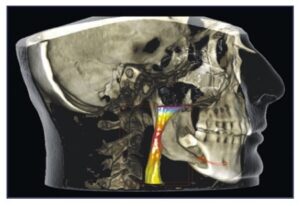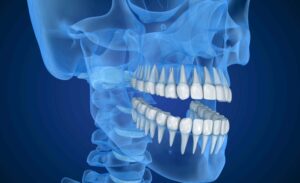Header logo
header top contact widget
Tooth Replacement
The “Why” & “How” of Dental Implants
Posted on Nov 09, 2022 by William J. Claiborne, DDS MS
According to the Centers for Disease Control & Prevention (CDC), over one-fourth (26%) of American adults ages 65 and older have 8 or less natural teeth. The CDC equates this number (having 8 or fewer teeth) as “severe tooth loss” since it impacts an individual’s ability to thoroughly eat a healthy diet.
An even worse statistic shared by the CDC is 1 in 6 (17%) adults ages 65 and older have lost all of their teeth.
When it comes to losing natural teeth, they also share that the most vulnerable older adults are those who are poor, have less than a high school education, or are cigarette smokers.
Being totally edentulous (having lost all teeth) amongst the 65 or older age group has fortunately declined over the years. The CDC shared that the figure dropped by more than 30% from 1999–2004 (when it was 27%) to 17% in 2011–2016. At least American adults are moving in the right direction.
https://www.cdc.gov/oralhealth/fast-facts/tooth-loss/index.html
Tooth loss is a bigger deal than is assumed by a large segment of the population. When a natural tooth is removed, its absence causes a reaction that begins below the gum line. What occurs initially is typically not obvious. Yet, the repercussions of “resorption” can become quite the dilemma.
The absence of a tooth root in the upper or lower jaw bone is a loss of stimulation to the bone mass where it was once positioned. These roots provide both stimulation and nourishment that enables the bone to maintain a healthy mass. Without the presence of tooth roots, the bone begins to “melt away.” This process is known as resorption.
Think of the stimulation that tooth roots provide to how you might muscle atrophy. We all know that muscles, not used, will shrink in mass. When the jaw bones are lacking stimulation by the tooth roots they’re designed to hold, bone mass begins to shrink.
Resorption begins shortly after the tooth root is removed. Once it starts, it continues at an ever-increasing pace. For example, the first year after a tooth root is missing, the loss of bone may be minimal. With each passing year, the pace of loss accelerates.
As the bone shrinks in height, the natural tooth roots adjacent to the area of missing teeth are subject to movement and root damage. On average, the next teeth you’re most likely to lose are the ones bordering areas of missing teeth.
Obviously, it is important to replace lost teeth before bone loss begins. For the support of remaining natural teeth, it’s also important to replace missing teeth as soon as possible so adjacent teeth can retain their proper positions. And, it’s HOW you replace them that’s most important.
Because dental implants replace the tooth above the gum line AND the root portion below it, the bone is able to retain its mass. Through the sturdy foundation of the jaw bone, dental implants are able to restore the look, feel and chewing stability like that of natural teeth.
As a periodontist, I specialize in the prevention, diagnosis, and treatment of all stages of periodontal (gum) disease. I also have advanced training and skills in the selection and placement of dental implants. In addition, periodontists are particularly skilled in performing cosmetic periodontal procedures.
Our Western NC periodontal dental office features some of the most advanced technology available. This cutting edge technology is beneficial in a number of ways, with much specifically helpful in optimal dental implant diagnosis and planning. This includes:
LANAP With PerioLase MVP 7 – Laser-Assisted New Attachment Procedure is an advanced protocol that efficiently and effectively treats advanced gum disease with the added advantages of a dental laser. For patients who are preparing for dental implant placement, resolving gum disease prior to treatment is mandatory. LANAP offers a non-surgical alternative for patients with moderate to severe periodontal disease with very little discomfort and a quick recovery time.
Cone Beam Imaging – These amazing 3D “x-rays’ are ideal for diagnosing and treatment planning. The highly-detailed images provide a clear view of the upper and lower jaw. Because cone beam radiographs show sagittal, axial, and coronal planes, locating and tracking nerve canals optimizes implant placement. The images are captured in a quick, painless process and at minimal levels of radiation.
CareStream Cone Beam Computer Tomography Imaging – This enhanced tomography works with 3D imaging for exceptional detail and range.
Computerized Dental Implant Placement – This system provides the futuristic ability to position dental implants before the process actually begins. Through computerized technology, the implants are selected and “ideally positioned” on a 3D model of the patient’s jaw. From this, a template is developed for optimal treatment success, even for complex cases.
CS 3600 Intraoral Scanner – Rather than make impressions with bulky, goopy trays, this scanner quickly and comfortably captures digital impressions accurately and easily. These are used to create precision models or appliances (dental implant crowns, bridges, or full arches). The scanner can also reach hard–to–access areas in the patient’s mouth for superior results with improved patient comfort.
Sedation – Our Asheville periodontal practice is known for its environment of comfort and respectful care. We understand that over 70 percent of the adult population have some level of dental fear or anxiety. For optimal comfort and relaxation, we offer several sedation options, including oral and IV sedation. With both sedation options, patients are closely monitored with advanced safety equipment throughout treatment.
• Oral sedation is a pill that helps patients relax. It also has an amnesiac effect, leaving most with little or no memory of treatment afterward.
• I.V. sedation (also known as ‘twilight sleep‘) places the patient in a deeper sleep state and erases memory of the procedure. It is administered by a Medical Doctor (MD) who is a board certified Anesthesiologist.
Ideal diagnosis is important, and can save the patient much in overall treatment costs. For example, when missing more than one tooth in one area, one implant can often hold two or a bridge of teeth. Several strategically-placed implants may also be used support a full arch of teeth.
Dental implants restore the ability to eat with stability, chew comfortably, laugh and speak with confidence. Dental implants do not decay and will never need root canals. They have an extremely high success rate, higher than any implant-in-bone option. And, Dental Implants are designed to last a lifetime. With proper selection and maintenance, they will never need replacing or repair.
Dental implants come in many sizes and shapes, each system designed to accommodate various needs and preferences. This means your implant can be chosen to suit your long-term goals.
Proper placement and support in caring for implants is an important part of a successful outcome. However, dental implants can fail. This is why a periodontal specialist can be an asset to your investment. When dental implants are chosen and placed by a Periodontist, he or she can select the one that will work best for you now and throughout your lifetime.
In our Asheville periodontal dental office, we combine technology with our advanced skills and compassionate approach to care so you can enjoy a comfortable, efficient experience that allows you to have optimal success.
Call 828-274-9440 to arrange a consultation. During this time, we can discuss treatment that can achieve your needs and goals as well as the process and anticipated costs.
Why Missing Teeth Cause Changes To Facial Appearance
Posted on Sep 30, 2022 by William J. Claiborne, DDS MS
The shape of our face is made by the bone structures beneath the skin. Essentially, we inherit our facial appearance from our ancestors. You may have your mom’s nose or your dad’s chin, but how you look is thanks to your genes.
However, facial appearance can also change due to a decline of bone mass. In dentistry, this is typically based on the presence, or absence, of natural teeth. Losing teeth – even when replaced by a denture, partial, or crown & bridge – leaves the upper and/or lower jaw bone susceptible to bone shrinkage. This is known as resorption.
The presence of natural teeth is vital to the health of upper and lower jaw bones. Tooth roots provide stimulation to the bone, stimulating blood flow that helps the jaws to maintain a healthy mass. Without tooth roots, the lack of stimulation causes the bone(s) to slowly decline.
Resorption causes the gum ridge to flatten out over time, giving your denture a continually-declining foundation. Application of denture adhesive becomes more frequent to prevent the denture from moving while eating, which causes uncomfortable rubbing. Laughing and speaking becomes overshadowed by the fear of embarrassing slips.
When dentures are first made, they may feel secure for the first five or so years. However, as resorption continues, relines help only on a temporary basis. As bone loss progresses, relines will last at less frequent intervals each time.
On average, denture wearers experience a 25% bone loss one year after natural teeth have been extracted. Three years later, 60% of the bone is gone. While natural teeth provide a biting force of 250 pounds, the average denture wearer bites with about 5 pounds of force.
Denture wearers are often surprised to learn that the pressure of wearing them actually accelerates resorption. For people who sleep in their dentures, the 24/7 pressure speeds the process of resorption even more.
To see the extent of bone loss you’ve experienced, remove your denture and look in the mirror. You may see deep wrinkles around the mouth and notice the corners of your mouth turn downward. If bone loss is severe, our mouth may appear to be collapsed inward with a pointed chin. Jowls may have formed on the sides of your face as facial muscles detect from the shrinking bone.
As a periodontist, I specialize in the treatment of all stages of periodontal (gum) disease as well as in the diagnosis and placement of dental implants. And, we are adept at placement of all types of dental implants. With over 40 different implant types, each designed to accommodate various needs, understanding the best type – and correct placement of it – can have a significant impact on your overall success rate.
For example, new designs in dental implant systems can overcome even severe bone loss. The All-On-4 dental implant can be placed in minimal bone using just four implants. Using specific angles, All-On-4 can support a full denture that is non-removable. And, because it is supported by implants placed in bone (just as natural tooth roots), biting and chewing stability is restored.
A periodontist can also assist patients prior to implant placement when severe bone loss has occurred. To ensure a sufficient level of bone mass to support the implanted portions, procedures such as bone generating materials or a “sinus lift” may be advised (to increase bone mass between the upper jaw and sinus cavity).
Our Asheville periodontal dental office is also known for our advanced technology and features (including our on-site 3D Cone Beam and laser). Additionally, our patients enjoy a high level of patient comfort through the administration of IV sedation (twilight sleep). This is administered by a Board Certified Anesthesiologist for optimal safety and comfort.
As dental implants have become a more practical and popular option, adults are turning away from dentures, partials, or bridges. In addition to restoring biting and chewing comfort and stability, implants offer a lifetime replacement option that actually enhances the well-being and lifespan of surrounding teeth.
Because of their ability to restore the presence of natural teeth to such a great extent, the dental profession now sees dental implants as the preferred choice for replacement for most patients. Although the overall treatment costs may seem greater initially, over time, it becomes obvious that the benefits far outweigh the expense.
When you consider that dental implants are designed to last a lifetime, the investment is a wise one. There are very little things in this day and age that will last as long as we do!
If you are considering dental implants, increase your potential for a successful outcome by asking a Periodontist to join your dentist in team treatment. Most general dentists have close relationships with periodontal specialists for implant placement and in treating gum disease.
Before you make your decision, you may wish to schedule a consultation to discuss your specific needs and desires. We are always happy to welcome new patients and being referred is not required. Call 828-274-9440.
Overcome Obstacles To Achieve A Confident Smile
Posted on Sep 12, 2022 by William J. Claiborne, DDS MS
It’s not unusual to see a new patient who has delayed seeking advanced dental care for many years because of perceived obstacles. I say “perceived” because many of these obstacles are not nearly so daunting once people actually learn more there are solutions for about any dilemma.
For example, a bride-to-be with a “gummy smile” realizes, after years of postponement, that she can have her gum line corrected through laser treatment that provides quick recovery with an easy payment plan.
Or, an individual who has worn a self-described “wobbly” denture for many years and overcame misperceptions about the need for pre-placement bone rebuilding. Through specially-designed and uniquely placed dental implants (“All-On-4”), patients may be able to bypass the extended treatment time and added expense to restore bone mass.
In a conversation once, a friend reminded me “we don’t know what we don’t know.” How true. Often, once we learn the details surrounding a big decision in our lives, moving forward becomes an easier process. Achieving goals gets closer and closer.
Below are a few of the common barriers that patients can often overcome when it comes to periodontal treatment or dental implants…
COST: There are few things in life that last a lifetime. When it comes to cosmetic gum enhancement and dental implants, the lasting benefits make these procedures an excellent investment. However, treatment cost can seem challenging to some budgets. For people who wish to enjoy the benefits of their results without straining their budget, payment plans can be the solution.
There are a number of these financial options, most requiring no down payment, are interest-free, and have no prepayment penalty. For some people who see the total treatment fee at first, vocalizing their concerns regarding payment is an uneasy thing to do. Yet, once we are made aware of the need for budget-friendly options, we are able to help many people move forward with treatment that can enhance physical appearance, self-confidence and emotional security. Those are pretty priceless benefits!
DENTAL FEAR: Dental fear and high anxiety associated with dental visits is not rare. As a matter of fact, some estimates rank this as affecting up to 60% of U.S. adults. There are a number of reasons that lead to these fears. For some people, they are able to overcome these fears once in the hands of a gentle, caring dentist. For those whose fears are so deeply embedded they cannot, we offer a special team who administer and oversee the safety of oral and IV sedation (twilight sleep).
In our office, we employe the skills of a a medical doctor to provide sedation and anesthesia for our patients. Dr. Stone has published several articles on techniques and safety in anesthesia as well as a book contribution on intravenous access.
TIME IN TREATMENT: We all live lives that are busy. Schedules seem to be overloaded so much of the time. This is why time in treatment can seem “too much” to add to one’s schedule. However, the advanced skills of a periodontal specialist, coupled with our immense array of advanced technology means we are able to alleviate many of these worries for our patients.
Once the patient’s imaging and treatment plan is in hand, we are often able to schedule patients soon thereafter. With the relaxation provided by our sedation options, we can perform long procedures in a single appointment rather than have the patient return for several appointments to complete treatment. Too, using our advanced imaging and computerized technology, treatment is more precise, often more conservative, and healing time improved.
TREATMENT SATISFACTION: The best way to make a decision that works to achieve your meeds and goals is through a consultation appointment. During this time, we can discuss what options are best for your individual needs, estimated treatment time, costs, and comfort options. This is a time when you can get to know us and we can give you the information that is factual and applicable to you. And, this is where trust is formed. I have a long-standing reputation for my commitment to patient excellence.
Begin by calling our Asheville periodontal dental office and speaking to our friendly staff at: 828-274-9440. Or, tap here to see our beautiful Western NC location.
Dental Implants’ Value Gives ‘Priceless’ Smiles
Posted on Jul 25, 2022 by William J. Claiborne, DDS MS
Times are tight. With the higher cost of gas, groceries and utilities, people are getting very value-conscious with their dollars. The ‘frills’ we once indulged in are now being scrutinized as to the value they truly bring.
Yet, there is no better time to explain the wisdom of investing in dental implants. For people who have shed dentures, partials, and gaps in their smiles with this ideal tooth replacement option, they are “priceless.”
Although our ‘permanent’ teeth are intended to last a lifetime, we know that not all of them do, no matter how diligent we are with at-home oral hygiene and regular dental check-ups. Teeth can break or be “knocked out.” Cavities can weaken a tooth, even after it’s been ‘filled.’ That’s why your general dentist may advise a crown, to help you avoid this risk.
A general dentist is a proponent of helping patients keep their natural teeth healthy. Your dentist knows that a lost tooth can lead to a long list of time and expense in the future. And, not promptly replacing a tooth can lead to a higher risk for adjacent teeth to be lost as well.
The teeth you see in the mirror are held in stable position because of the roots that are firmly embedded in the jaw bone. In these roots are veins and nerves that extend into the bone that supports them. From this, the jaw bone is supplied with blood while the presence of the roots provide stimulation that helps the bone to maintain its mass.
The stimulation that tooth roots provide is similar to how muscle will atrophy if not used. For example, when an arm or leg is confined to a cast for an extended time, the doctor will often advise physical therapy to rebuild the muscle after its removed. Unused, the muscle mass declines.
Unfortunately, when the jaw bones decline in mass, rebuilding requires the intervention of a periodontal specialist. (Fear not, however. A periodontist can provide this.)
Bone loss is what causes a change in how partials and dentures fit. These appliances, when first made, are custom-made for the unique contours of your gum “ridge.” A ridge is the raised arch in your mouth where tooth roots are (or were once) held.
As the bone height declines, the denture or partial becomes less secure as the foundation flattens. Adhesives or pastes are needed more frequently. Relines may help, but only temporarily.
And, the down side continues. When bone loss begins, it accelerates with each passing year. Eventually, a shrinking jaw bone reveals itself in changes in facial appearance. Initially, there may be deep wrinkling around the mouth. The corners of the mouth turn downward. Jowls form and the chin becomes pointed.
As bone loss becomes more severe, the mouth seems to sink into the face. The nose and chin get closer, giving a “granny look”. A thin jaw bone is also more vulnerable to breaks.
This is where dental implants have a particular edge (amongst other things). Like natural teeth, implants are held by the upper or lower jaws. Dental implants are able to mimic the stimulation needed to prevent the process of “resorption,” as its known.
Another bonus of dental implants is their ability to help surrounding natural teeth remain healthy. Unlike a crown-&-bridge combination, dental implants do not rely on neighboring teeth for support. Thus, the integrity of surrounding teeth is protected.
Because dental implants are supported by the jaw bone, sturdy and dependable biting and chewing strength is restored. For people who experienced the frustrations of trying to eat with a “wobbly” or “slippery” denture, they love the restored ability to eat a healthy diet. And, the shadow of embarrssment no longer looms when eating out with friends.
Dental implants come in many sizes and shapes, each system designed to accommodate various needs and preferences. Couple this with the extremely high success rate of dental implants, higher than any implant-in-bone option.
 Dental implants are also designed to last a lifetime. I can think of very few things that provide this kind of value. With proper selection and maintenance, they will never need replacing or repair. This makes them an excellent investment.
Dental implants are also designed to last a lifetime. I can think of very few things that provide this kind of value. With proper selection and maintenance, they will never need replacing or repair. This makes them an excellent investment.
A periodontist is a dental specialist who is trained to understand the intricate concepts involved in selecting the proper type of implant and skilled at placing implants at proper depths and angles. A periodontist is also able to optimize patient comfort during treatment and throughout the healing phase.
In addition to this advanced training, our dental office offers some of the most advanced technology available. This aids in the diagnosis and treatment planning of dental implants, providing patients with optimized comfort and outcomes. This technology, combined with our advanced skill level, can help you enjoy a comfortable, efficient experience that allows you to enjoy a lifetime of confident smiles.
As a periodontist in Western NC, we have also developed a reputation for respectful, gentle care. Here, oral and IV sedation are available as needed, administered safely and to the highest standards by a doctor of anesthesiology. If fear or anxiety is a concern, feel free to mention these during a private consultation.
To learn more or to schedule a consultation, call 828-274-9440. Or, ask to begin with an initial periodontal examination.
Recent Posts
Categories
Archives
- September 2024
- August 2024
- July 2024
- June 2024
- May 2024
- April 2024
- March 2024
- February 2024
- January 2024
- December 2023
- November 2023
- October 2023
- September 2023
- August 2023
- July 2023
- June 2023
- May 2023
- April 2023
- March 2023
- February 2023
- January 2023
- December 2022
- November 2022
- October 2022
- September 2022
- August 2022
- July 2022
- June 2022
- May 2022
- April 2022
- March 2022
- February 2022
- January 2022
- December 2021
- November 2021
- October 2021
- September 2021
- August 2021
- July 2021
- June 2021
- May 2021
- April 2021
- March 2021
- February 2021
- January 2021
- December 2020
- November 2020
- October 2020
- September 2020
- August 2020
- July 2020
- June 2020
- May 2020
- April 2020
- March 2020
- February 2020
- January 2020
- December 2019
- November 2019
- October 2019
- September 2019
- August 2019
- July 2019
- June 2019
- May 2019
- April 2019
- March 2019
- February 2019
- January 2019
- December 2018
- November 2018
- October 2018
- September 2018
- August 2018
- July 2018
- June 2018
- May 2018
- April 2018
- March 2018
- February 2018
- January 2018
- December 2017
- November 2017
- October 2017
- September 2017
- August 2017
- July 2017
- June 2017
- May 2017
- April 2017
- March 2017
- February 2017
- January 2017
- December 2016
- November 2016
- October 2016
- September 2016
- August 2016
- July 2016
- June 2016
- May 2016
- April 2016
- March 2016
- February 2016
- January 2016
- December 2015
- November 2015
- October 2015
- September 2015
- August 2015
- July 2015
- June 2015
- May 2015
- April 2015
- March 2015
- February 2015
- January 2015
- December 2014
- November 2014
- October 2014
- September 2014
- August 2014
- July 2014
- June 2014
- May 2014
- April 2014
- March 2014
- February 2014
- January 2014
- December 2013
- November 2013
- October 2013
- September 2013
- August 2013
- July 2013
- June 2013
- May 2013
- April 2013
- March 2013
- February 2013
- January 2013
- December 2012
- November 2012
- October 2012
- September 2012
- August 2012
- July 2012
- June 2012


